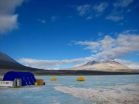Bioengineered marine algae expands environments where biofuels can be produced
2012-11-27
(Press-News.org) Biologists at UC San Diego have demonstrated for the first time that marine algae can be just as capable as fresh water algae in producing biofuels.
The scientists genetically engineered marine algae to produce five different kinds of industrially important enzymes and say the same process they used could be employed to enhance the yield of petroleum-like compounds from these salt water algae. Their achievement is detailed in a paper published online in the current issue of the scientific journal Algal Research.
The ability to genetically transform marine algae into a biofuel crop is important because it expands the kinds of environments in which algae can be conceivably grown for biofuels. Corn, for example, which is used to produce ethanol biofuel, requires prime farmland and lots of fresh water. But the UC San Diego study suggests that algal biofuels can be produced in the ocean or in the brackish water of tidelands or even on agricultural land on which crops can no longer be grown because of high salt content in the soil.
"What our research shows is that we can achieve in marine species exactly what we've already done in fresh water species," said Stephen Mayfield, a professor of biology at UC San Diego, who headed the research project. "There are about 10 million acres of land across the United States where crops can no longer be grown that could be used to produce algae for biofuels. Marine species of algae tend to tolerate a range of salt environments, but many fresh water species don't do the reverse. They don't tolerate any salt in the environment."
"The algal community has worked on fresh water species of algae for 40 years," added Mayfield, who also directs the San Diego Center for Algae Biotechnology, or SD-CAB, a consortium of research institutions in the region working to make algal biofuels a viable transportation fuel in the future. "We know how to grow them, manipulate them genetically, express recombinant proteins—all of the things required to make biofuels viable. It was always assumed that we could do the same thing in marine species, but there was always some debate in the community as to whether that could really be done."
That debate came to a head last month when a National Academy of Sciences committee examining the future potential of algal biofuels for the U.S. Department of Energy published a report pointing out that the production of algal biofuels might be limited by fresh water because no published research study had demonstrated the feasibility of using engineered marine species of algae.
"But now we've done it," said Mayfield. "What this means is that you can use ocean water to grow the algae that will be used to produce biofuels. And once you can use ocean water, you are no longer limited by the constraints associated with fresh water. Ocean water is simply not a limited resource on this planet."
The UC San Diego biologists focused their study on a marine species of alga, Dunaliella tertiolecta, which had been earlier targeted by scientists for potential biofuels production because of its high oil content and ability to grow rapidly under a wide range of salinity and acidic conditions. To demonstrate that it could be used in commercial biofuel production, they introduced five genes into the alga that produced five different kinds of enzymes that could be used in an industrial setting to not only convert biomass to fuel, but also increase nutrient availability in animal feed. Some of these enzymes, for example, came from a fungus that degrades plant material into simple sugars.
The scientists said in their paper that "we hope to eventually determine whether whole algae, post-oil extraction, may be used as a feed additive to improve animal feeds. Animal feed is a relatively high volume market that may be able to benefit from algae-produced proteins as a feed additive."
INFORMATION:
The UC San Diego biologists—who included D. Ryan Georgianna, Michael Hannon, Marina Marcuschi, Alex Lewis, James Hyun—collaborated on their project with three scientists from Sapphire Energy, Inc., a San Diego algal biotechnology company—Shuiqin Wu, Kyle Botsch and Michael Mendez. Their research effort was funded by the Air Force Office of Scientific Research and the State of California Energy Commission.
END
ELSE PRESS RELEASES FROM THIS DATE:
2012-11-27
This press release is available in Spanish.
Student engagement is not independent of the type of school attended.Nor is it independent of the organisational development of the school.The school's organisational style affects the work of its teaching staff, which, in turn, has repercussions on the performance and engagement of their students.As IkerRos, the UPV/EHU researcher, has been able to verify in his PhD thesis, these factors vary when comparing public schools, subsidised schools and co-operative schools, the latter being the ones that fare best.
"The study of ...
2012-11-27
(NEW YORK, N.Y., November 26, 2012) – Autism Speaks Chief Science Officer Geraldine Dawson, Ph.D. describes how the dramatic progress in autism research has paralleled increased recognition of autism's prevalence and financial impact in the December issue of the Archives of General Psychiatry published on line today. "This issue of the journal features three articles on autism," she writes in her editorial. "A decade ago, the journal published about the same number of autism articles per year."
Dr. Dawson also notes that, while the funding for autism research has dramatically ...
2012-11-27
An area of the brain called the orbitofrontal cortex is responsible for decisions made on the spur of the moment, but not those made based on prior experience or habit, according to a new basic science study from substance abuse researchers at the University of Maryland School of Medicine and the National Institute on Drug Abuse (NIDA). Scientists had previously believed that the area of the brain was responsible for both types of behavior and decision-making. The distinction is critical to understanding the neurobiology of decision-making, particularly with regard to substance ...
2012-11-27
SAN DIEGO, Calif. (November 26, 2012) The Algae Biomass Organization, the trade association for the U.S. algae industry today hailed the findings of a University of California at San Diego study that concludes, for the first time, that marine (saltwater) algae can be just as capable as freshwater algae in producing biofuels. The research is documented in a peer-reviewed paper published online in the current issue of the scientific journal Algal Research.
"What this means is that you can use ocean water to grow the algae that will be used to produce biofuels. And once ...
2012-11-27
EAST LANSING, Mich. — Where there's water there's life – even in brine beneath 60 feet of Antarctic ice, in permanent darkness and subzero temperatures.
While Lake Vida, located in the northernmost of the McMurdo Dry Valleys of East Antarctica, will never be a vacation destination, it is home to some newly discovered hearty microbes. In the current issue of the Proceedings of the National Academy of Sciences, Nathaniel Ostrom, Michigan State University zoologist, has co-authored "Microbial Life at -13ºC in the Brine of an Ice-Sealed Antarctic Lake."
Ostrom was part ...
2012-11-27
The wild and dramatic cascade of ice into the ocean from Alaska's Columbia Glacier, an iconic glacier featured in the documentary "Chasing Ice" and one of the fastest moving glaciers in the world, will cease around 2020, according to a study by the University of Colorado Boulder.
A computer model predicts the retreat of the Columbia Glacier will stop when the glacier reaches a new stable position -- roughly 15 miles upstream from the stable position it occupied prior to the 1980s. The team, headed by lead author William Colgan of the CU-Boulder headquartered Cooperative ...
2012-11-27
SEATTLE—After gastric bypass surgery, diabetes goes away for some people—often even before they lose much weight. So does that mean gastric surgery "cures" diabetes? Not necessarily, according to the largest community-based study of long-term diabetes outcomes after bariatric surgery. For most people in the study, e-published in advance of print in Obesity Surgery, diabetes either never remitted after gastric surgery or relapsed within five years.
Among the two thirds of the study's patients whose diabetes at first went away, more than a third re-developed diabetes again ...
2012-11-27
They say that the eyes are the windows to the soul. However, to get a real idea of what a person is up to, according to UC Santa Barbara researchers Miguel Eckstein and Matt Peterson, the best place to check is right below the eyes. Their findings are published in the Proceedings of the National Academy of Sciences.
"It's pretty fast, it's effortless –– we're not really aware of what we're doing," said Miguel Eckstein, professor of psychology in the Department of Psychological & Brain Sciences. Using an eye tracker and more than 100 photos of faces and participants, Eckstein ...
2012-11-27
PHILADELPHIA — Electronic circuits are typically integrated in rigid silicon wafers, but flexibility opens up a wide range of applications. In a world where electronics are becoming more pervasive, flexibility is a highly desirable trait, but finding materials with the right mix of performance and manufacturing cost remains a challenge.
Now a team of researchers from the University of Pennsylvania has shown that nanoscale particles, or nanocrystals, of the semiconductor cadmium selenide can be "printed" or "coated" on flexible plastics to form high-performance electronics.
The ...
2012-11-27
You may have received CPR training some time ago, but would you remember the proper technique in an emergency? Would you know what to do in the event of an earthquake or a fire? A new UCLA psychology study shows that people often do not recall things they have seen — or at least walked by — hundreds of times.
For the study, 54 people who work in the same building were asked if they knew the location of the fire extinguisher nearest their office. While many of the participants had worked in their offices for years and had passed the bright red extinguishers several times ...
LAST 30 PRESS RELEASES:
[Press-News.org] Bioengineered marine algae expands environments where biofuels can be produced





